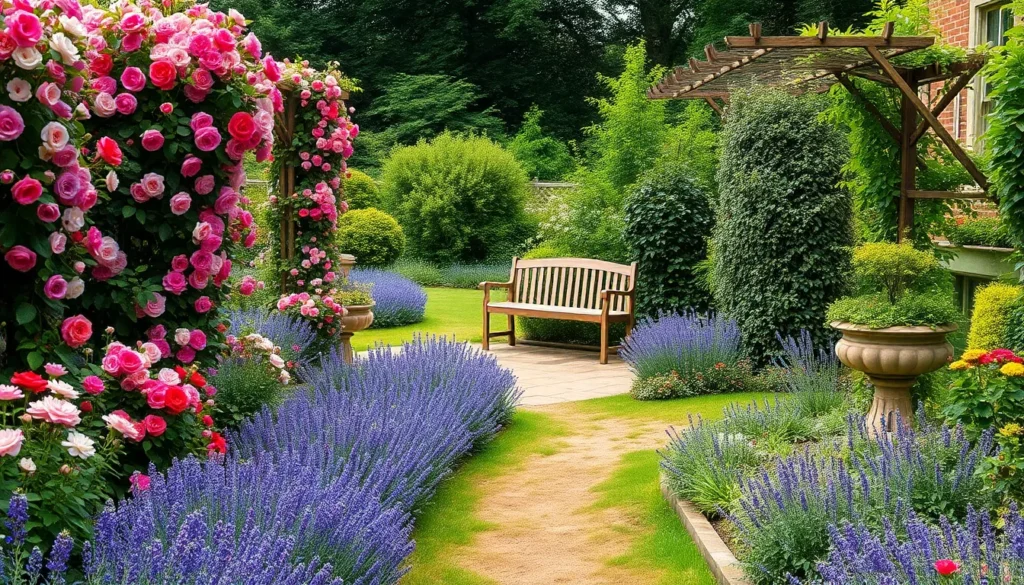We’ve all dreamed of creating that perfect English garden – a romantic sanctuary where climbing roses cascade over weathered trellises and lavender borders frame meandering stone pathways. There’s something magical about the effortless elegance of traditional English garden design that captures our hearts and transforms ordinary outdoor spaces into enchanting retreats.
The beauty of English garden style lies in its ability to blend structured formality with wild natural charm. We’re talking about gardens that feel both carefully planned and delightfully spontaneous where cottage perennials spill over neat hedgerows and ancient trees provide dramatic focal points throughout the seasons.
Whether you’re working with a sprawling countryside estate or a compact urban backyard we’ll show you how to capture that quintessential English garden aesthetic. From selecting the right plants and materials to mastering the art of layered planting these proven design ideas will help you create your own slice of English countryside paradise.
Create a Classic English Cottage Garden with Mixed Borders
Mixed borders form the heart of every authentic English cottage garden, creating layers of color and texture that bloom throughout the seasons. We’ll transform your outdoor space into a romantic sanctuary using traditional design principles that have defined English gardens for centuries.
Plant Traditional English Flowers Like Roses and Lavender
Roses establish the foundation of our English cottage garden design, with climbing varieties like ‘Eden’ and ‘New Dawn’ reaching heights of 8-12 feet along fences and walls. We recommend planting David Austin roses such as ‘Graham Thomas’ and ‘Lady of Shalott’ for their repeat blooming and classic fragrance. Shrub roses need spacing of 3-4 feet apart to allow proper air circulation and prevent disease issues.
Lavender creates aromatic borders that attract beneficial pollinators while providing year-round structure in our mixed plantings. English lavender (Lavandula angustifolia) varieties like ‘Hidcote’ and ‘Munstead’ thrive in full sun conditions and well-draining soil. We plant lavender in groups of 3-5 specimens for maximum visual impact, spacing them 18-24 inches apart.
Traditional cottage flowers fill gaps between our anchor plants, including foxgloves that self-seed naturally throughout the garden space. Hollyhocks tower at 6-8 feet tall against walls and fences, while delphiniums provide vertical spikes of blue and purple in early summer. Sweet peas climb through other plants, offering cut flowers and delicate fragrance from June through September.
| Plant Type | Spacing | Height | Bloom Time |
|---|---|---|---|
| Climbing Roses | 6-8 feet | 8-12 feet | June-October |
| Shrub Roses | 3-4 feet | 4-6 feet | May-October |
| Lavender | 18-24 inches | 2-3 feet | June-August |
| Foxgloves | 12-18 inches | 4-6 feet | May-July |
| Hollyhocks | 18-24 inches | 6-8 feet | July-September |
Design Curved Pathways Through Dense Plantings
Curved pathways guide visitors through our cottage garden while creating intimate viewing angles of different plant combinations. We design gentle S-curves that naturally lead the eye around corners and reveal hidden garden rooms. Pathways should measure 3-4 feet wide to accommodate comfortable walking and wheelbarrow access for maintenance tasks.
Natural materials enhance the authentic English garden aesthetic, with reclaimed brick, York stone, or gravel creating surfaces that complement the informal planting style. We avoid straight lines and geometric patterns that conflict with the organic cottage garden approach. Stepping stones placed 18-24 inches apart create rhythm while allowing plants to spill over edges naturally.
Edge plantings soften pathway borders using low-growing herbs and perennials that release fragrance when brushed against. Catmint, thyme, and chamomile thrive along walkway edges, creating living carpets that blur the boundaries between path and planting bed. We plant these edge specimens closer to the path than their mature spread to encourage natural overflow.
Incorporate Climbing Vines on Trellises and Arbors
Vertical structures add essential height and architectural interest to our English cottage garden design while maximizing growing space in smaller areas. We install wooden trellises, obelisks, and arbors using traditional materials like cedar or oak that weather naturally over time. Metal supports in dark green or black powder coating blend seamlessly with foliage while providing sturdy anchoring for heavy climbers.
Clematis varieties offer spectacular seasonal displays when trained up supports, with early flowering types like ‘Montana’ blooming in May followed by large-flowered hybrids throughout summer. We pair clematis with climbing roses for extended bloom periods, planting the clematis on the shady side of rose supports. Late-flowering clematis like ‘Jackmanii’ provide autumn color when most other climbers are finishing their display.
Honeysuckle and jasmine create fragrant evening gardens that attract night-flying moths and provide romantic ambiance during summer entertaining. Native honeysuckle (Lonicera periclymenum) supports local wildlife while offering cream and pink tubular flowers from June through September. We train these vigorous climbers on sturdy pergolas or arbors that can support their mature weight of 15-20 pounds per plant.
Design a Formal English Parterre Garden Layout
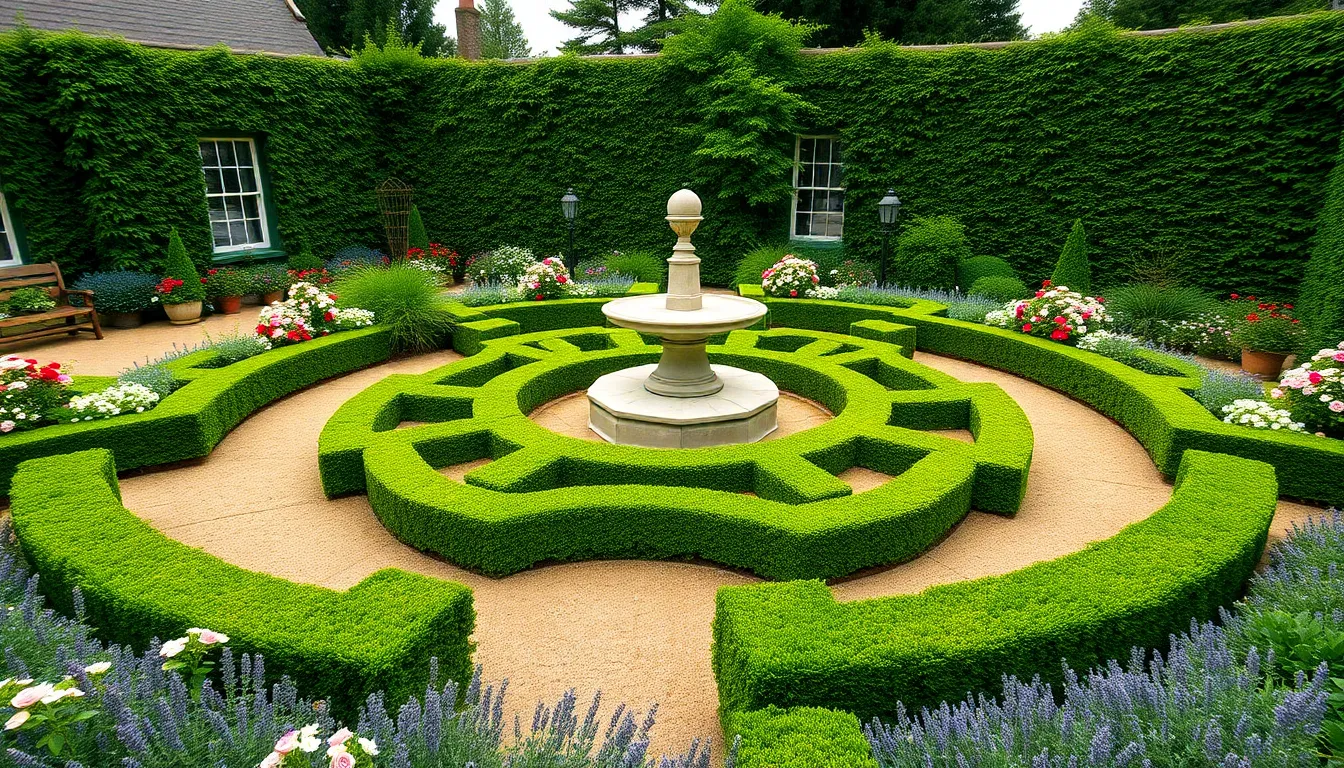
Formal English parterre gardens offer a striking contrast to cottage garden styles with their precise geometric patterns and structured elegance. We’ll show you how to create this sophisticated garden design that transforms any outdoor space into an ornamental masterpiece.
Use Boxwood Hedges to Create Geometric Patterns
Boxwood hedges form the backbone of any successful parterre garden design. We recommend using these evergreen plants because they can be clipped into precise shapes that maintain crisp geometric patterns year-round. The dense foliage of boxwood allows us to create intricate boundaries that define each ornamental bed with mathematical precision.
Trimming these hedges requires regular attention to preserve their formal appearance. We suggest maintaining hedge heights between 12-18 inches to create proper proportion within the garden layout. Professional gardeners often choose boxwood varieties like Buxus sempervirens for their durability and slow growth patterns that reduce maintenance frequency.
Add Central Focal Points Like Fountains or Sundials
Fountains serve as magnificent centerpieces that draw the eye while providing soothing water sounds throughout the garden. We position these water features at key intersection points where pathways meet to maximize their visual impact. The gentle bubbling creates a peaceful atmosphere that enhances the formal garden’s serene character.
Sundials offer historic charm as traditional focal points that add educational value to your parterre design. We recommend placing these timepieces on elevated pedestals to ensure visibility from multiple viewing angles. Bronze or stone sundials work particularly well because they develop attractive patinas over time that complement the garden’s mature appearance.
Plant Seasonal Flowers Within Structured Borders
Seasonal flowers bring vibrant color and life to the geometric framework created by your boxwood hedges. We select plants that complement the formal design aesthetic, including roses, lavender, and other traditional English varieties that bloom in succession throughout growing seasons. These plantings should maintain neat appearances that don’t overwhelm the structured parterre pattern.
Spacing becomes crucial when arranging flowers within the bordered sections of your garden. We typically plant in organized rows or clusters that echo the geometric themes established by the hedge boundaries. Regular deadheading and pruning keep these seasonal displays looking tidy and ensure continuous blooms that enhance the garden’s visual appeal throughout spring, summer, and fall months.
Establish a Traditional English Herb Garden
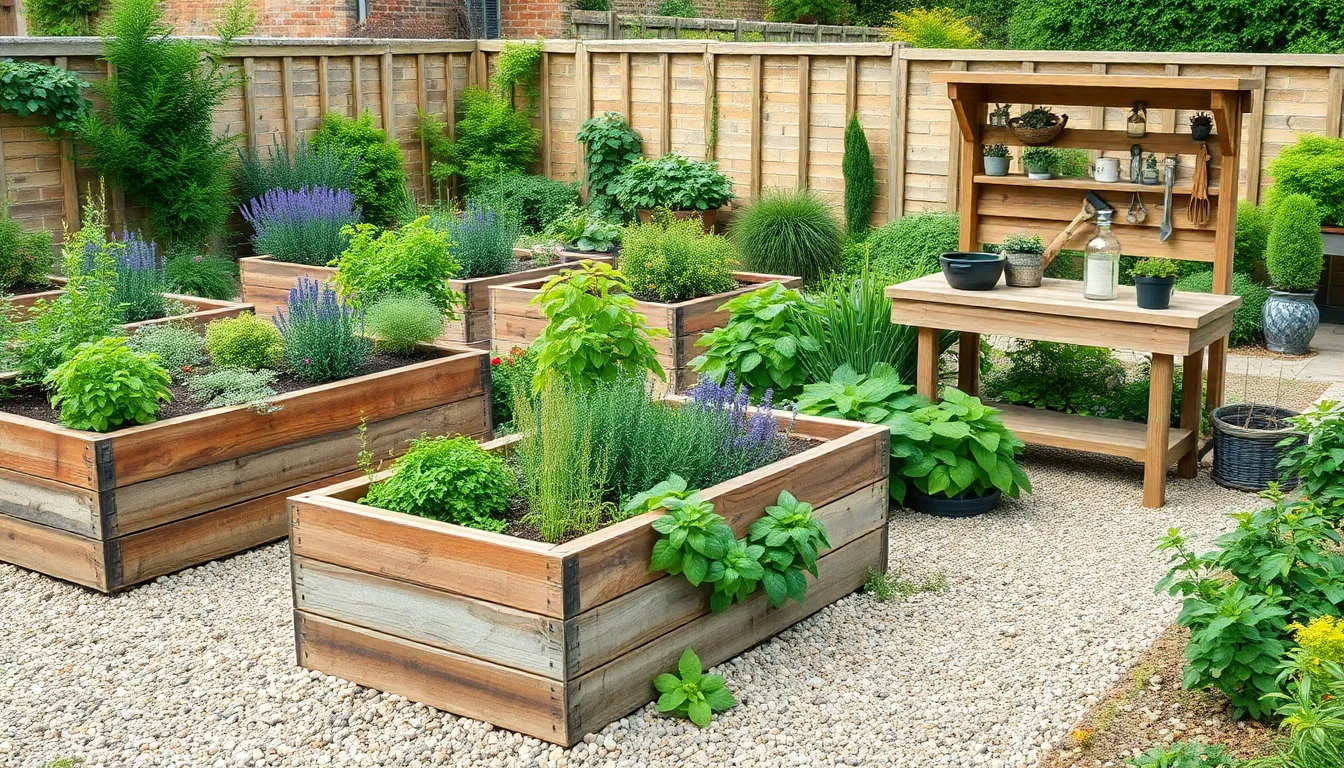
Traditional English herb gardens combine functionality with timeless beauty, creating organized spaces that serve both culinary and medicinal purposes. We’ll guide you through designing a structured yet visually appealing herb garden that reflects classic English gardening principles.
Create Designated Sections for Culinary and Medicinal Herbs
Designating exact areas for different herb types streamlines both harvesting and garden maintenance. Culinary herbs like rosemary, thyme, sage, and basil should be positioned near your kitchen for convenient daily use. Medicinal selections including lavender, chamomile, and calendula work best in areas where their decorative qualities can shine.
Separating these herbs enhances your garden’s visual organization while creating clear thematic focus. We recommend grouping similar herbs together to simplify watering schedules and care requirements. This approach also prevents faster-spreading herbs from overwhelming more delicate varieties.
Design Raised Beds with Gravel Pathways
Raised beds offer superior drainage, easier access, and cleaner growing conditions for your herb collection. Wood, stone, or brick construction aligns perfectly with classic English garden materials and provides lasting durability. These elevated planting areas prevent soil compaction while making harvesting and maintenance more comfortable.
Surrounding raised beds with gravel pathways creates structure and prevents muddy walkways during wet weather. Gravel provides excellent drainage while complementing your garden’s overall aesthetic appeal. We suggest using locally sourced gravel that matches your home’s architectural style for the most authentic English garden appearance.
Install a Potting Bench for Garden Maintenance
Potting benches support essential garden upkeep by providing dedicated workspace for planting seedlings, repotting, and tool storage. Position your bench near the herb garden for maximum efficiency during daily gardening tasks. Wood or metal construction options both reflect traditional English garden design while offering practical functionality.
We recommend choosing a potting bench with built-in storage shelves for seed packets, hand tools, and small containers. This workspace becomes invaluable during busy planting seasons and helps maintain your garden’s organized appearance. Consider adding hooks or pegboards above the bench for hanging frequently used tools.
Build Classic English Garden Structures and Features

Creating architectural elements transforms our garden space into an authentic English industry. We’ll focus on three essential structures that define the classic English garden aesthetic while providing practical functionality.
Install a Traditional Greenhouse or Conservatory
Greenhouses provide year-round plant cultivation opportunities that extend our gardening season beyond natural limitations. We can incorporate features like dedicated potting areas and multi-level shelving systems to maximize growing space efficiency. Traditional greenhouse designs complement English garden aesthetics while offering practical benefits for seed starting and tender plant protection.
Conservatories create sunny indoor spaces where we can enjoy plants and nature throughout all seasons. These glass structures serve as transitional areas between indoor and outdoor living spaces. We’ll position conservatories to capture maximum sunlight while providing comfortable seating areas for relaxation and plant observation.
Construct Wooden Garden Benches and Seating Areas
Wooden benches create inviting rest spots strategically placed throughout our garden design. We’ll position these seating areas near focal points like herbaceous borders filled with lupines, delphiniums, and foxgloves to maximize viewing pleasure. Strategic bench placement encourages garden exploration while providing comfortable observation points.
Arches and gazebos serve as architectural focal points that frame garden pathways and create defined spaces. These wooden structures support climbing plants while adding vertical interest to our industry design. We can use them to mark transitions between different garden areas or highlight exact plantings.
Add Stone or Brick Garden Walls for Privacy
Stone and brick walls provide essential privacy while defining distinct garden areas within our overall design. These permanent structures create intimate spaces for different garden themes and activities. We’ll construct walls using traditional materials that complement the English garden aesthetic while serving practical boundary functions.
Topiary trees and hedges enhance privacy through living barriers that add formality to our garden design. These planted elements work alongside hardscape walls to create layered privacy answers. We can shape hedges into geometric forms that complement formal garden areas while maintaining year-round screening capabilities.
Incorporate Water Features Inspired by English Gardens
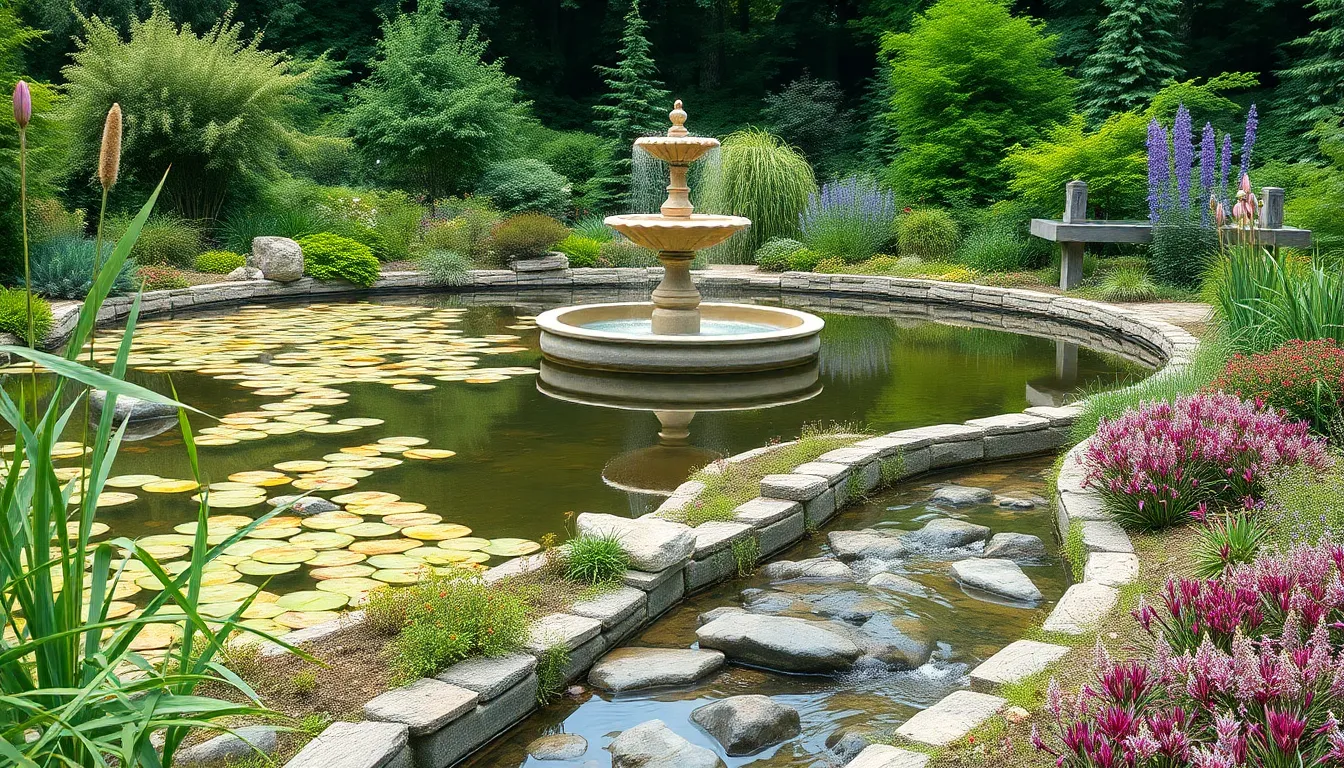
Water features bring life and tranquility to English gardens while improving their naturalistic charm. These elements create focal points that complement the architectural structures and plantings we’ve established in our garden design.
Design a Natural Pond with Native Aquatic Plants
Natural ponds serve as the heart of many traditional English gardens, providing both visual appeal and wildlife habitat. We recommend creating a pond that feels organic to the industry, using irregular shapes that mimic natural water bodies found in the English countryside.
Water lilies make excellent centerpiece plants for our pond, offering beautiful blooms that float gracefully on the surface during summer months. Cattails add vertical interest along the pond’s edges while providing natural filtration and wildlife shelter. Native aquatic plants like arrowhead and pickerel rush create layers of texture and help maintain water quality naturally.
Position the pond where it’ll receive morning sunlight but afternoon shade to prevent excessive algae growth. Edge plantings of hostas, ferns, and astilbe create smooth transitions between the water feature and surrounding garden beds. This naturalistic approach ensures our pond complements the informal elements we’ve incorporated throughout our English garden design.
Install a Classic English Garden Fountain
Grand multi-tiered fountains represent the epitome of traditional English industry design, adding both visual drama and soothing sounds to our garden space. Stone or concrete fountains work best for achieving authentic English garden aesthetics, with their substantial presence commanding attention as central focal points.
Tiered designs create cascading water effects that produce gentle, relaxing sounds throughout the garden. We suggest positioning the fountain at the intersection of major pathways or as the centerpiece of formal garden rooms we’ve created. This placement ensures the fountain becomes a natural gathering point that draws visitors deeper into our garden design.
Classical styling with carved details or simple geometric forms works best for maintaining consistency with other formal elements like parterre gardens or structured herb areas. Regular maintenance keeps the fountain functioning properly while preserving its role as a stunning architectural feature that enhances our garden’s overall sophistication.
Create Meandering Streams with Stone Borders
Meandering streams with stone borders capture the essence of English countryside landscapes while adding movement and sound to our garden design. These water features work particularly well connecting different garden areas or leading visitors along the curved pathways we’ve established.
Stone borders provide structure while maintaining the stream’s natural appearance, using local materials that complement existing hardscaping elements. We recommend varying the stone sizes and placement to create realistic water flow patterns that feel authentic to natural stream beds. This approach enhances the garden’s naturalistic feel while providing visual interest throughout the seasons.
Moving water creates soothing background sounds that mask urban noise while attracting beneficial wildlife to our garden space. Strategic placement of moisture-loving plants like Japanese iris, astilbe, and cardinal flower along the stream banks creates lush, colorful displays that thrive in these conditions. This integration ensures our water feature becomes part of the garden’s living network rather than a standalone element.
Plant an English Woodland Garden Theme
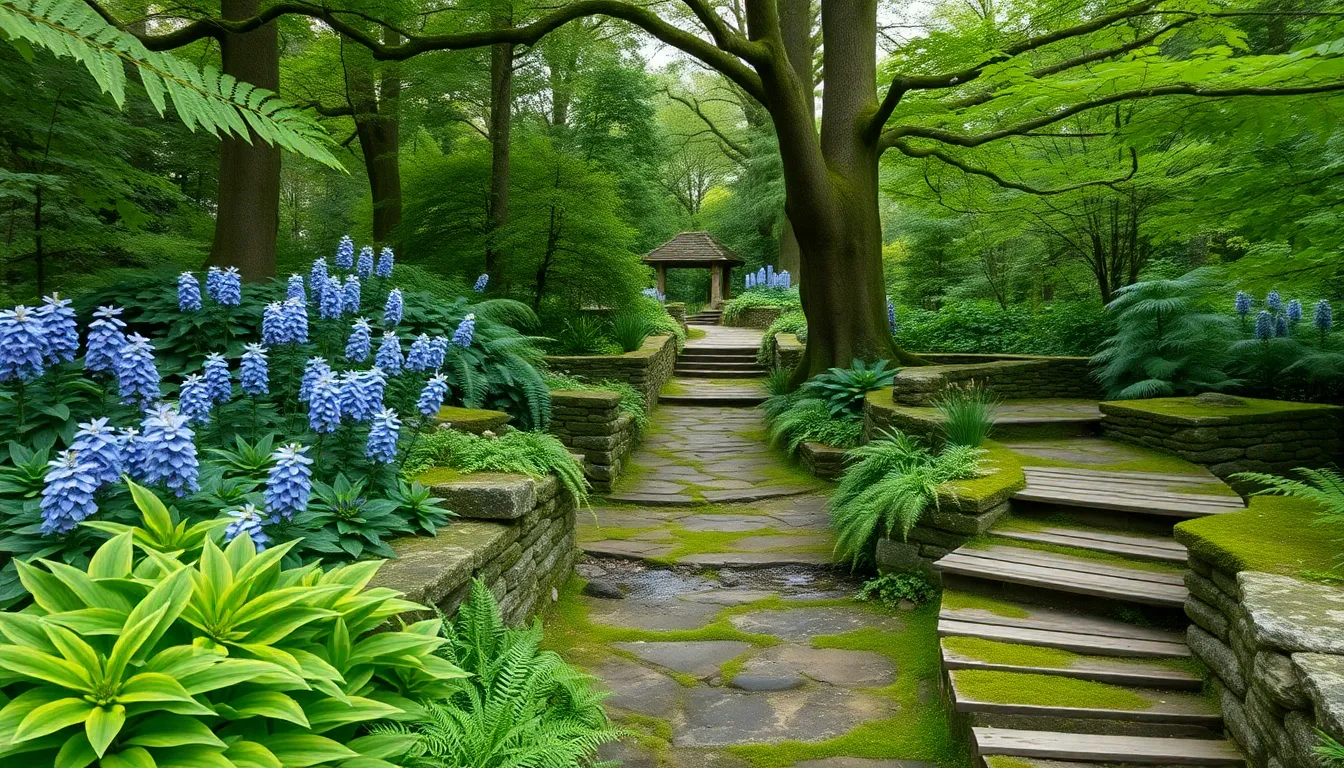
English woodland gardens capture the serene beauty of natural forest environments. We’ll transform shaded areas into enchanting spaces that mirror the English countryside’s wooded landscapes.
Choose Shade-Loving Plants Like Hostas and Ferns
Shade loving plants form the foundation of our English woodland garden design. Hostas bring dramatic foliage variations with their heart shaped leaves in colors ranging from deep green to variegated gold and white patterns. We’ll position large hostas like ‘Sum and Substance’ as anchor plants while using smaller varieties such as ‘Blue Mouse Ears’ for border accents.
Ferns create natural texture layers throughout our woodland space. Royal ferns and Christmas ferns thrive in shaded conditions while adding delicate fronds that dance in gentle breezes. We can plant these native species beneath existing trees where traditional flowering plants struggle to establish.
Combine these foundational plants with other shade tolerant perennials like astilbe and heuchera to create diverse color palettes. Astilbe produces feathery plumes in pink white and red shades during summer months while heuchera offers colorful foliage throughout growing seasons.
Create Natural Walking Trails Through Tree Canopies
Natural walking trails guide visitors through our woodland garden’s most captivating features. We’ll design meandering paths using materials that complement the forest environment such as wood chips bark mulch or crushed stone that blend seamlessly with natural surroundings.
Tree canopies provide overhead structure while filtering sunlight to create dappled lighting effects below. Position pathways to wind between mature trees rather than cutting straight lines through the space. This approach preserves existing root systems while creating intimate garden rooms beneath different canopy sections.
Install stepping stones or rustic wooden boardwalks in areas where moisture collects naturally. These elevated surfaces protect plant roots from foot traffic while maintaining accessibility during wet conditions. We can incorporate gentle curves that reveal new garden vistas around each bend.
Add Moss-Covered Stone Features and Sculptures
Moss covered stone features bring authentic woodland character to our English garden theme. Large boulders and stone outcroppings create natural focal points while providing surfaces for moss colonization over time. We’ll position these elements strategically along pathways and in garden clearings where they anchor planting compositions.
Stone sculptures blend artistic elements with natural materials to enhance our woodland atmosphere. Choose pieces carved from local stone materials that weather naturally and develop patina over seasons. Classical urns garden statuary and abstract forms work equally well when they complement rather than compete with surrounding plantings.
Encourage moss growth on stone surfaces by creating consistently moist microclimates around features. We can achieve this by positioning stones in partially shaded locations and ensuring adequate humidity through nearby water features or irrigation systems. Existing moss can be transplanted from other garden areas to accelerate the naturalization process.
Design a Traditional English Rose Garden
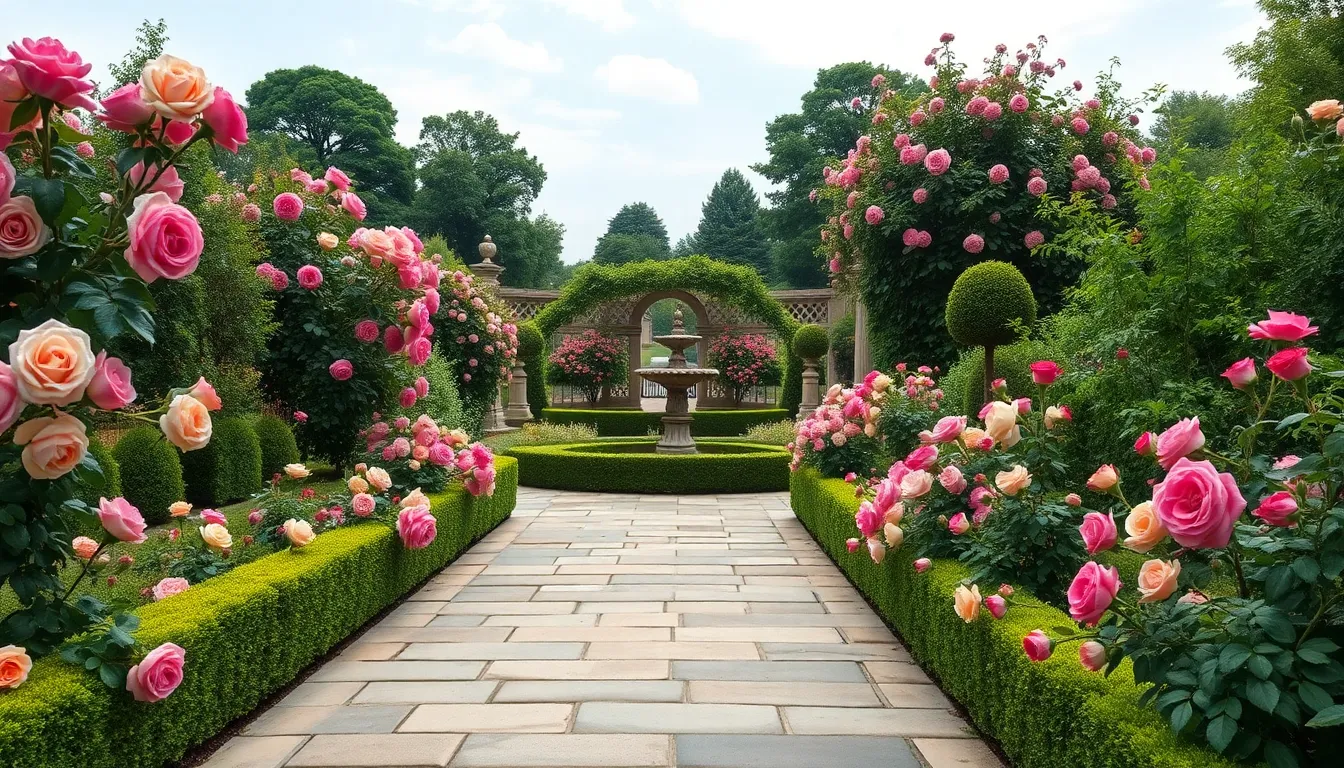
Creating a traditional English rose garden brings timeless elegance and romantic charm to any outdoor space. We’ll guide you through establishing this quintessential garden style that celebrates the beauty of heritage roses.
Select Heritage and David Austin Rose Varieties
Heritage roses form the foundation of authentic English rose gardens with their classic appearance and historical significance. We recommend incorporating David Austin’s renowned varieties like ‘Juliet’ and ‘Desdemona’ for their distinctive peony-like blooms and vibrant colors that capture the essence of traditional English gardens.
David Austin roses combine the best qualities of old garden roses with modern disease resistance and repeat flowering capabilities. These varieties offer the romantic fragrance and full-bodied blooms that define classic English garden aesthetics while providing reliable performance throughout the growing season.
Traditional rose varieties like gallicas, damasks, and albas add authentic character to your garden design. Consider planting Rosa gallica ‘Officinalis’ for its deep pink petals and historical significance, or Rosa alba ‘Maiden’s Blush’ for its soft pink blooms and exceptional hardiness.
Climbing roses create vertical interest and romantic appeal when trained on supporting structures. Select varieties like ‘Lady of Shalott’ or ‘Generous Gardener’ that produce cascading blooms and complement the formal garden structure while providing impressive height and coverage.
Create Formal Rose Beds with Supporting Structures
Symmetrical layouts establish the structured elegance characteristic of traditional English rose gardens. We design geometric pathways using brick, stone, or gravel that create meandering paths inviting exploration while maintaining the garden’s formal appearance through balanced plant placement.
Boxwood hedges define rose bed borders with their crisp, evergreen foliage that maintains structure year-round. These neatly defined borders create formal elegance while providing a contrasting backdrop that highlights rose blooms and colors throughout the growing season.
Supporting structures like trellises, arbors, and pergolas enhance the garden’s romantic atmosphere while providing essential support for climbing roses. Install these architectural elements strategically to create focal points and guide visitors through different garden areas while supporting vigorous climbing varieties.
Classical elements including fountains, statues, and well-manicured topiaries add refinement to formal rose beds. Position these features as central focal points that draw the eye and create visual anchors within the structured garden design while maintaining the sophisticated English garden aesthetic.
Plan Seasonal Companion Plantings for Year-Round Interest
Spring plantings begin the growing season with early-flowering bulbs like tulips and daffodils planted alongside roses. These companion plants provide colorful displays before roses reach their peak blooming period, ensuring continuous garden interest from early spring through late fall.
Summer perennials like lavender and coneflowers provide consistent blooms throughout the warmest months while complementing rose colors and fragrances. Plant these varieties in strategic locations to create layered textures and extend the garden’s flowering period beyond the primary rose season.
Autumn additions include fall-blooming asters and sedum that extend garden interest into cooler months when roses begin their dormant period. These late-season performers maintain color and structure while providing important habitat for beneficial insects preparing for winter.
Winter elements featuring evergreen shrubs and winter-flowering heathers maintain garden beauty during colder months when roses are dormant. Incorporate these plants to provide structure, color, and visual interest throughout the year while ensuring your traditional English rose garden remains attractive in every season.
Establish an English Kitchen Garden Layout
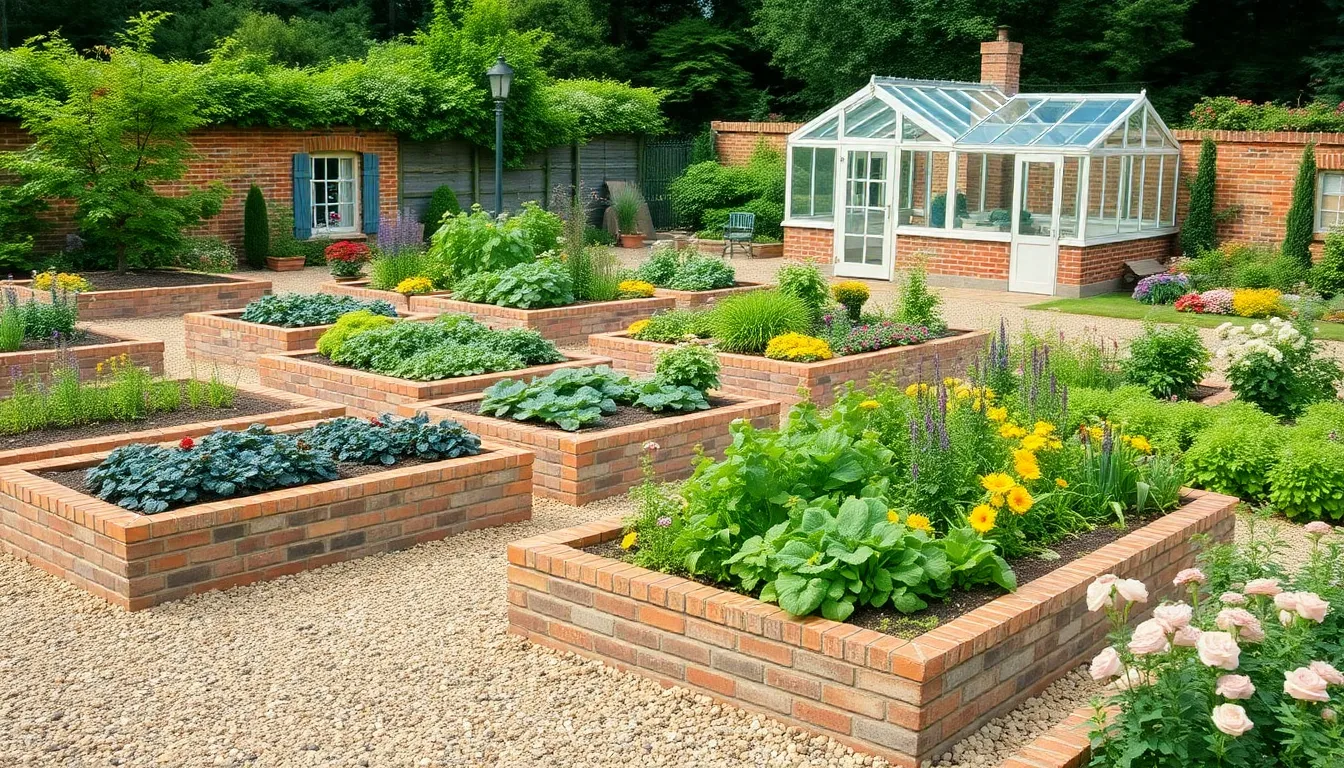
An English kitchen garden combines practical growing space with timeless aesthetic appeal. This traditional approach centers on symmetrical design, efficient plant accessibility, and seasonal productivity while maintaining the classic charm that defines authentic English gardens.
Design Rectangular Vegetable Plots with Gravel Paths
Rectangular vegetable plots form the backbone of traditional English kitchen gardens, offering both visual structure and practical growing benefits. We recommend creating raised beds edged with brick, stone, or neatly trimmed boxwood to define each growing area while providing excellent drainage for root vegetables and leafy greens.
Gravel paths between beds serve multiple essential functions in maintaining garden organization and plant health. These pathways suppress weeds naturally, provide superior drainage during England’s frequent rain showers, and create clean walking surfaces that remain accessible throughout the growing season.
Strategic bed positioning maximizes sunlight exposure for heat-loving crops like tomatoes and peppers while allowing cooler areas for lettuce and spinach. We suggest centering the layout around a focal point such as a fruit tree, greenhouse, or decorative sundial to create visual harmony that connects all garden elements.
Efficient crop rotation becomes simpler with this structured approach, allowing gardeners to move plant families systematically between beds each season. This method prevents soil depletion and reduces pest problems while maintaining the garden’s orderly appearance year after year.
Install Cold Frames for Season Extension
Cold frames extend the English growing season significantly by protecting tender plants from harsh weather conditions. These transparent-roofed enclosures capture solar energy during the day and retain warmth overnight, creating microclimates that support plant growth when outdoor temperatures drop.
Positioning cold frames near the kitchen garden provides convenient access for daily monitoring and harvesting of protected crops. We recommend placing them in south-facing locations to maximize sun exposure while ensuring easy integration with existing garden pathways and structures.
Early spring vegetables like lettuce, radishes, and herbs thrive in cold frame environments, allowing gardeners to harvest fresh produce weeks before outdoor planting becomes viable. Similarly, autumn crops continue producing well into winter months when protected by these simple but effective structures.
Construction materials for cold frames range from recycled windows and wooden frames to modern polycarbonate panels with aluminum structures. We suggest choosing designs that complement existing garden architecture while providing adequate ventilation systems to prevent overheating during sunny days.
Create a Cutting Garden Section for Fresh Flowers
A dedicated cutting garden section provides continuous fresh blooms for indoor arrangements while maintaining the kitchen garden’s productive focus. This specialized area combines annuals and perennials specifically selected for their vase life, fragrance, and seasonal blooming patterns.
Strategic placement near kitchen garden borders or along main pathways ensures easy access for daily flower gathering without disrupting vegetable cultivation areas. We recommend grouping flowers by height and bloom time to create efficient harvesting zones that maintain attractive displays throughout the growing season.
| Flower Type | Bloom Period | Vase Life | Best Uses |
|---|---|---|---|
| Roses | June-October | 5-7 days | Formal arrangements |
| Lavender | July-September | 7-10 days | Dried arrangements |
| Delphiniums | June-August | 3-5 days | Tall centerpieces |
| Sweet Peas | May-September | 4-6 days | Cottage bouquets |
Popular English cutting garden flowers include climbing roses for vertical interest, fragrant lavender that dries beautifully, tall delphiniums that create dramatic arrangements, and sweet peas that provide continuous color and scent. These varieties thrive in England’s mild climate while offering diverse textures and colors for seasonal bouquets.
Succession planting ensures continuous flower production by staggering seed sowings and bulb plantings throughout the season. We suggest incorporating early spring bulbs, summer annuals, and autumn-blooming perennials to maintain cutting material from March through November.
Add Authentic English Garden Accessories and Decor

Weathered stone planters and traditional gates transform any garden space into an authentic English countryside retreat. Vintage style tools complete this timeless aesthetic while adding functional charm.
Choose Weathered Stone Planters and Urns
Weathered stone planters add rustic elegance that perfectly complements flowers and shrubs in traditional English gardens. We recommend selecting planters with natural patina and moss growth to achieve that coveted aged appearance. Position larger urns as focal points at pathway intersections or garden entrances where they’ll create maximum visual impact.
Stone planters work exceptionally well with climbing roses, lavender, and boxwood arrangements that echo classic English garden themes. Consider mixing different sizes of weathered containers to create layered displays that mirror the natural randomness found in cottage garden designs. Place smaller stone planters along curved pathways to guide visitors through your garden spaces while maintaining authentic period charm.
Install Traditional Garden Gates and Fencing
Traditional garden gates and fencing define distinct garden spaces while maintaining the formal structure essential to English garden design. We suggest choosing wooden or metal fencing with ornate gates that feature classic English motifs like scrollwork or geometric patterns. Install gates at entrances to different garden rooms such as the herb garden, rose garden, or kitchen garden areas.
Wooden picket fencing painted in traditional colors like sage green or cream white creates boundaries without blocking garden views completely. Metal wrought iron fencing adds more formal elegance and works particularly well around parterre gardens or formal rose beds. Consider adding climbing roses or clematis to fence lines where they’ll soften the structural elements while maintaining privacy and definition.
Select Vintage Style Garden Tools and Equipment
Vintage style garden tools enhance your garden’s authentic charm while providing practical functionality for daily maintenance tasks. We recommend incorporating old fashioned tools like wooden handled rakes, metal watering cans, and traditional hand tools that reflect historical English gardening practices. Display these tools on potting benches or hang them from greenhouse walls where they’ll serve as both functional equipment and decorative elements.
Choose tools with brass fittings and wooden handles that develop beautiful patina over time through regular use. Traditional copper watering cans work particularly well for herb gardens and cottage garden borders where their warm tones complement natural plantings. Store vintage style tools in weathered wooden sheds or against stone walls where they’ll contribute to the garden’s overall period atmosphere.
Plan Seasonal Interest Throughout Your English Garden
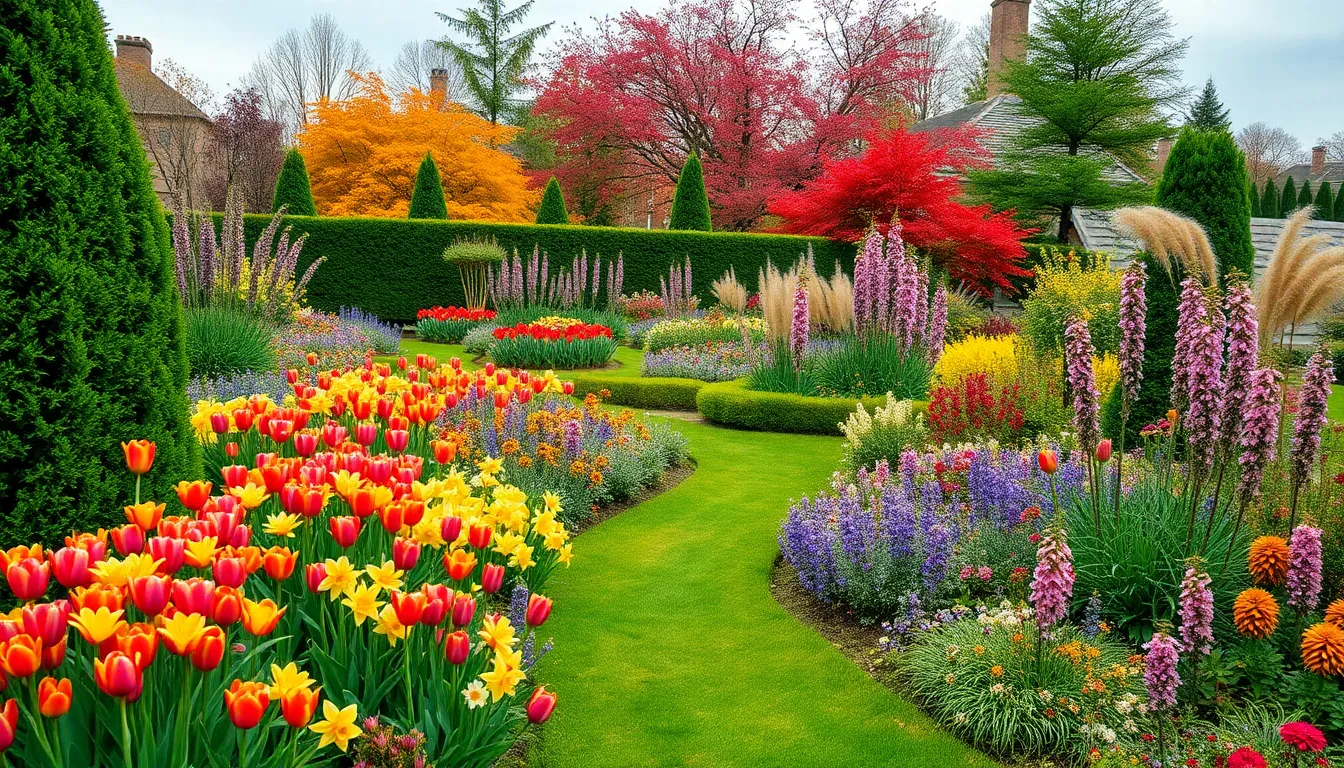
Creating a truly captivating English garden requires thoughtful planning to ensure visual appeal throughout all four seasons. Seasonal interest transforms your outdoor space from a fleeting spring display into a year-round masterpiece that evolves with each changing month.
Design Spring Bulb Displays and Early Bloomers
Spring bulb displays form the foundation of our seasonal English garden strategy. We recommend planting tulips, daffodils, and hyacinths in clusters of 10-15 bulbs per variety to create impactful color drifts that mirror traditional English garden aesthetics. These early bloomers provide essential color when most perennials remain dormant.
Early-blooming perennials like forget-me-nots and bluebells extend our spring palette beyond bulbs. Forget-me-nots self-seed readily and create charming blue carpets beneath deciduous trees, while bluebells naturalize in woodland areas to establish that quintessential English countryside feeling. We position these perennials in partially shaded areas where they’ll receive morning sun and afternoon protection.
Layering spring bloomers by height creates visual depth and maximizes garden space. Tall tulips and daffodils anchor the back of borders, while shorter varieties like crocuses and grape hyacinths fill foreground spaces. This strategic placement ensures every square foot contributes to our spring display while maintaining proper growing conditions for each species.
Create Summer Peak Season Color Combinations
Summer peak season color combinations showcase the classic English garden at its most spectacular. We incorporate flowering perennials like delphiniums, larkspur, foxgloves, and roses to create the traditional cottage garden aesthetic that defines English landscapes. These plants provide vertical interest and sustained blooms throughout the growing season.
Wisteria adds cascading drama to our summer displays with its abundant purple or white flower clusters. We train wisteria along pergolas, arbors, or garden walls where its vigorous growth creates natural canopies and privacy screens. The timing of wisteria blooms perfectly complements early summer perennials like peonies and iris.
Foliage plants with patterned leaves provide essential texture contrasts against flowering specimens. Hostas, ferns, and ornamental grasses create cool green backgrounds that make bright flower colors appear more vibrant. We position these textural elements strategically to break up solid masses of color and provide visual resting points throughout our garden composition.
Incorporate Autumn Foliage and Winter Structure Plants
Autumn foliage transforms our English garden with warm seasonal colors that extend visual interest beyond summer blooms. We select trees and shrubs like Japanese maples, oak varieties, and flowering dogwoods that provide reliable fall color. These woody plants serve as garden anchors while delivering spectacular seasonal displays.
Flowering mums bridge the gap between summer perennials and winter dormancy with their rich autumn hues. We plant hardy chrysanthemum varieties in yellows, oranges, and deep purples that complement changing leaf colors. These late-season bloomers often continue flowering until the first hard frost.
Winter structure plants maintain garden appeal during dormant months when herbaceous perennials disappear. We leave ornamental grasses, seed heads, and architectural plants untrimmed to provide winter interest and wildlife shelter. Evergreen hedges and topiary forms create permanent structure that anchors our garden design year-round.
Strategic placement of evergreen elements ensures our garden maintains visual weight during winter months. Boxwood hedges, yew topiaries, and conifer specimens provide consistent green backdrops that highlight winter bark textures and remaining berries. These structural elements form the backbone of our English garden while supporting seasonal plantings throughout the year.
Conclusion
Creating an authentic English garden requires thoughtful planning and attention to detail but the rewards are immeasurable. Whether you’re drawn to the romantic cottage style or prefer the structured elegance of a formal parterre we’ve shown you how to achieve these timeless looks in your own outdoor space.
The key to success lies in understanding that English gardens are about more than just plants – they’re about creating harmonious spaces that blend beauty with functionality. From selecting the right architectural elements to planning for year-round interest every decision contributes to the overall garden experience.
Remember that these gardens evolve over time so don’t feel pressured to carry out everything at once. Start with one style that speaks to you and gradually build upon it. With patience and persistence you’ll soon have your own slice of English countryside right outside your door.
Frequently Asked Questions
What are the main types of English garden styles?
The five main English garden styles include the romantic cottage garden with mixed borders and climbing roses, the formal parterre garden featuring geometric patterns and boxwood hedges, the traditional herb garden combining functionality with beauty, the serene woodland garden, and the elegant English rose garden with heritage varieties and structured layouts.
How do I create an authentic English cottage garden look?
Create mixed borders with traditional English flowers like climbing roses, lavender, and seasonal perennials. Design curved pathways for intimacy, layer plants for year-round color and texture, and incorporate vertical structures like trellises and arbors to support climbing plants while maintaining the garden’s natural charm.
What defines a formal English parterre garden?
A formal parterre garden features precise geometric patterns created with boxwood hedges, structured elegance, and crisp year-round shapes. Add central focal points like fountains or sundials, plant seasonal flowers within structured borders, and maintain neat appearances through careful spacing and regular maintenance.
How should I design a traditional English herb garden?
Create designated sections for culinary and medicinal herbs, position culinary herbs near the kitchen, and place medicinal herbs for decorative appeal. Design raised beds with gravel pathways for drainage and accessibility, and install a potting bench for efficient maintenance and tool storage.
What architectural elements enhance an English garden?
Install traditional greenhouses or conservatories for year-round cultivation, construct wooden benches near focal points for optimal viewing, add stone or brick walls for privacy and area definition, and incorporate topiary trees and hedges to enhance formality and create layered privacy solutions.
How do water features improve English gardens?
Water features bring life and tranquility while enhancing naturalistic charm. Design natural ponds with native aquatic plants like water lilies, install classic fountains as dramatic centerpieces for soothing sounds, and create meandering streams with stone borders to connect garden areas and integrate moisture-loving plants.
What makes an English rose garden special?
English rose gardens feature heritage and David Austin varieties combining classic beauty with modern resilience. Create formal beds with supporting structures, maintain symmetrical layouts with boxwood hedges, and plan seasonal companion plantings including spring bulbs, summer perennials, autumn bloomers, and winter elements.
How do I plan an English kitchen garden?
Design rectangular vegetable plots with gravel paths for organization and drainage, position beds for optimal sunlight exposure, use cold frames to extend growing seasons, and include a cutting garden section for indoor flower arrangements with succession planting for continuous blooms.
What accessories complete an English garden aesthetic?
Use weathered stone planters with natural patina for rustic elegance, install ornate gates and fencing to define spaces, incorporate vintage-style tools reflecting historical practices, and select accessories that create a cohesive and charming English garden atmosphere throughout the space.
How do I ensure year-round interest in my English garden?
Plant spring bulbs like tulips and daffodils in clusters, add early-blooming perennials such as forget-me-nots, incorporate summer flowering perennials for vibrant colors, use trees and shrubs for autumn foliage, and include winter structure plants to maintain visual appeal during dormancy.

